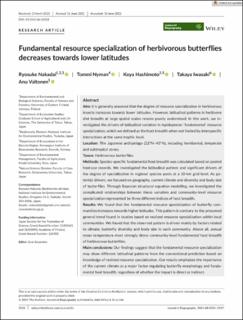| dc.description.abstract | Aim It is generally assumed that the degree of resource specialization in herbivorous insects increases towards lower latitudes. However, latitudinal patterns in herbivore diet breadth at large spatial scales remain poorly understood. In this work, we investigated the drivers of latitudinal variation in lepidopteran ‘fundamental’ resource specialization, which we defined as the host breadth when not limited by interspecific interactions at the same trophic level. Location The Japanese archipelago (22°N–45°N), including hemiboreal, temperate and subtropical zones. Taxon Herbivorous butterflies. Methods Species-specific fundamental host breadth was calculated based on pooled host-use records. We investigated the latitudinal pattern and significant drivers of the degree of specialization in regional species pools at a 10-km grid level. As potential drivers, we focused on geography, current climate and diversity and body size of butterflies. Through Bayesian structural equation modelling, we investigated the complicated relationships between these variables and community-level resource specialization represented by three different indices of host breadth. Results We found that the fundamental resource specialization of butterfly communities increases towards higher latitudes. This pattern is contrary to the presumed general trend found in studies based on realized resource specialization within local communities. We found that the observed pattern is driven mainly by factors related to climate, butterfly diversity and body size in each community. Above all, annual mean temperature most strongly drove community-level fundamental host breadth of herbivorous butterflies. Main conclusions Our findings suggest that the fundamental resource specialization may show different latitudinal patterns from the conventional prediction based on knowledge of realized resource specialization. Our results emphasize the importance of the current climate as a major factor regulating butterfly morphology and fundamental host breadth, regardless of whether the impact is direct or indirect. | en_US |

